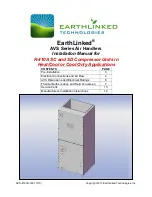
1307SDH_RDH--EN,
page 10/32
5.2 RDH
Model
5.2.1 Location
heater
When installing ensure the total outdoor elements of the
installation will not jeopardize the integrity of the
premises security.
A distance of 500 mm must be maintained between the
deck on which the appliance is installed and any air inlet
to the appliance. We also refer to figure 2b.
The location where the air heater is to be installed, must
provide sufficient space around the heater for servicing
and to allow the flue products to escape freely. A
minimum distance of 1500 mm must be maintained on
the controls side of the appliance.
When installed at ground level the entire installation
should be protected by a fence to guard against damage
and to protect the public from possible injury.
5.2.2 Installation
heater
Ensure that the structural elements which will be used to
support the appliance are adequate to carry the weight
of the appliance and its ancillary components i.e. the
ductwork system.
Ensure that the air heater is installed in a level plain and
that the surface onto which it is installed is vibration free.
The air heater must be fastened securely to any base
mount frame work. Roofcurbs are manufactured from
galvanised mild steel and should be fixed prior to siting
the appliance.
It is necessary to provide weatherproof seals between the
appliance and the structural elements of the building.
Exposed ducting should be insulated and covered with a
weatherproof membrane.
The duct connection to the appliance should be made
using flexible connections to reduce noise transmission
and allow for thermal expansion of the air heating
module.
When siting the appliance and unloading, extreme care
must be exercised to ensure that the slings etc employed
do not damage the casing. The weatherproofing will
become unsealed should any damage be sustained. Sling
spreaders must be used to provide clearance between the
appliance and the slings. Figure 4 shows the location of
spreaders and slinging points provided for this purpose.
Figure 4 : Lifting sling points
(Use all provided sling points !)
5.3 Duct
connections
The air heaters are designed to be used in conjunction with
intake and or discharge ducting. A positive seal should be
made between any ducting and the air heater. A flexible
connection is desirable to eliminate transmission of noise
and to take account of thermal expansion. Figure 5
illustrates a method of connection between the appliance
and the duct using a proprietary patented connection
system.
Consideration should be given to the application of duct
fittings directly connected to the appliance.Air inlet and
outlet elbows, transitions etc. should be designed to ensure
an unrestricted and turbulent free air flow. This requirement
is to ensure that an even air temperature is maintained
when leaving the appliance thus eliminating heat exchanger
"hot-spots" and nuisance shut-down of the burner due to
over heating.





































